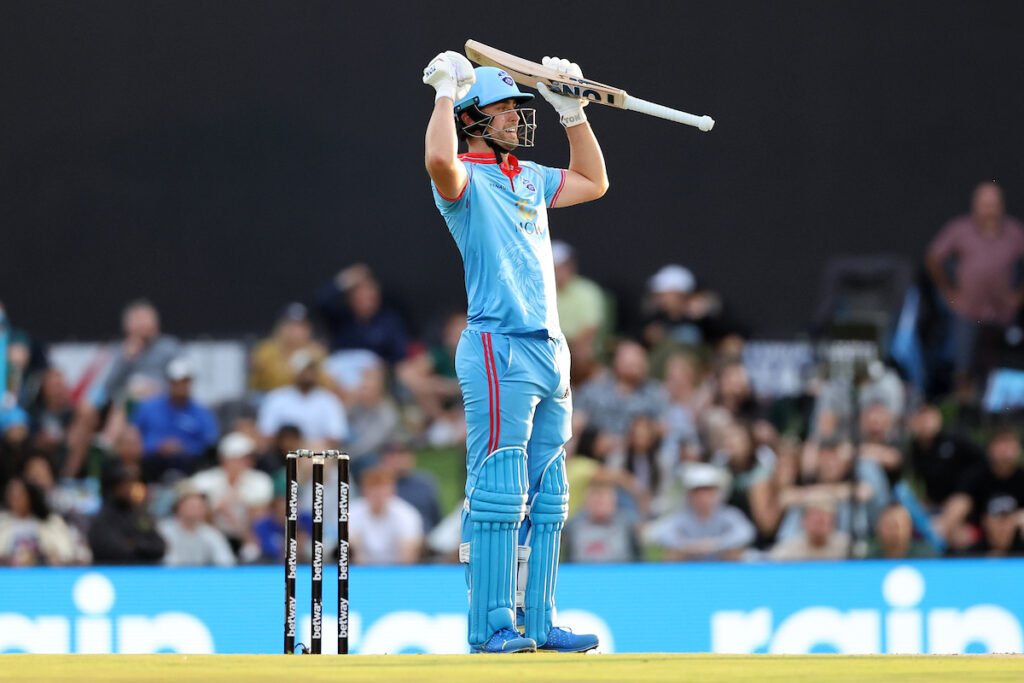SA20 is about adapting to different types of pitches; Pretoria Capitals show how 0

Photo by Sportzpics
One of the joys of the SA20 is that there are different types of pitches that are used in the tournament and teams are often forced to think on their feet and adapt at short notice. The Pretoria Capitals were quicker and better in adapting to the SuperSport Park wicket on Thursday night and duly notched their first win of the season, beating the Durban Super Giants by 17 runs.
When returning captain Wayne Parnell won the toss and elected to bat first, eyebrows were raised because Centurion is traditionally a venue full of runs, where defending any sort of total can be tough at altitude on a pitch full of runs and a smallish, very quick outfield.
But this pitch behaved slightly differently. The best time to bat was up front and batting second was just that little bit harder as the ball gripped on a dry surface once the new-ball shine had gone.
Will Jacks was the man who seized the moment as he plundered the fastest century in SA20 history, needing just 41 balls to get there, and his onslaught up front gave the Pretoria Capitals such a good platform that their deceleration in the second half of their innings and a collapse of five wickets for seven runs at the death did not cost them the match.
A total of 204 for nine was certainly competitive and the Durban Super Giants were unable to replicate Jacks’ aggression up front and finished on 187 for seven.
Junior Dala, the Durban Super Giants strike bowler but usually based at SuperSport Park, said “It was a game that was probably won and lost in the powerplays. We showed fight with both bat and ball at the end, but we probably conceded 15 to 20 runs too many in our bowling powerplay as Will came hard at us.”
With Jacks hammering eight fours and nine sixes, including a straight hit into the media centre that I have never seen before at SuperSport Park, and fellow Englishman Phil Salt also scoring freely with 23 off 13 balls, the Capitals were off to a blazing start.
The opening pair lashed 75 runs off the first five-and-a-half overs, but then crucially, the Super Giants began taking wickets. As the ball became older, so the cutters came out and the visitors kept chipping away at the Pretoria batting line-up.
“With the newer ball, your cutters and slower balls just skidded on more, but by the eighth or ninth over they were beginning to grip more. But you still had to be smart and understand your match-ups,” Dala later explained.
Jacks reached his hundred two balls quicker than Durban’s Heinrich Klaasen had done in his landmark effort in this same fixture last season, the ball whizzing off his bat in a sparkling innings that should attract many, many views on SA20’s various digital platforms.
But when Jacks (101 off 42 balls) cut his next ball after reaching his second T20 century straight to point, Dwaine Pretorius making the breakthrough, the Pretoria Capitals innings rather lost its fizz. The wicket left them 151 for four after 13 overs, and although Colin Ingram scored a busy 43 off 23 deliveries, their momentum petered out.
Marcus Stoinis (4-0-37-1), playing his first SA20 match having just arrived from the Big Bash in Australia, lit the fuse for the bowling comeback as he dismissed Jimmy Neesham and conceded just two runs in the 18th over; Reece Topley (4-1-34-3) then bowled an astonishing double-wicket maiden and Dala (4-0-32-2) also took two wickets in the final over while conceding just seven runs.
Jacks then toyed with the Super Giants with the ball as well. He opened the bowling and conceded just seven runs in the first over, before returning and claiming two wickets – Kyle Mayers bowled for 1 and the massive scalp of Klaasen for just a single. The off-spinner finished with two for 18 in his three overs.
Opener Matthew Breetzke ought to have batted deeper after scoring 33 off 24 balls but he steered Parnell straight to deep cover and the Capitals just kept chipping away with regular wickets.
Quinton de Kock made 25 off 20 before he sent a mistimed pull off Hardus Viljoen straight to deep midwicket, Stoinis hit a couple of big sixes before holing out to Neesham, and Jacks then took a boundary catch to dismiss Keemo Paul (18) off Parnell.
Jon-Jon Smuts scored a defiant 27, but not even a late flurry from Pretorius (19* off 10) and Keshav Maharaj (25* off 12) was enough to take the Super Giants to a win.
Eathan Bosch was the other Pretoria bowler to excel, showing what a top-class talent he is as he adapted beautifully to the pitch, bowling effective cutters and conceding just 18 runs in his three overs.
![IMG_1541[1]](http://kenborland.com/wp-content/uploads/2016/01/IMG_15411-300x200.jpg)
![IMG_1538[1]](http://kenborland.com/wp-content/uploads/2016/01/IMG_15381-300x200.jpg)
![IMG_1533[1]](http://kenborland.com/wp-content/uploads/2016/01/IMG_15331-300x200.jpg)
![IMG_1540[1]](http://kenborland.com/wp-content/uploads/2016/01/IMG_15401-300x200.jpg)
![IMG_1545[1]](http://kenborland.com/wp-content/uploads/2016/01/IMG_15451-e1667319814711-200x300.jpg)